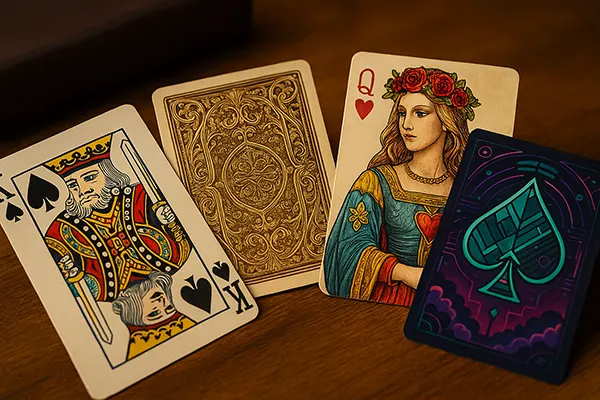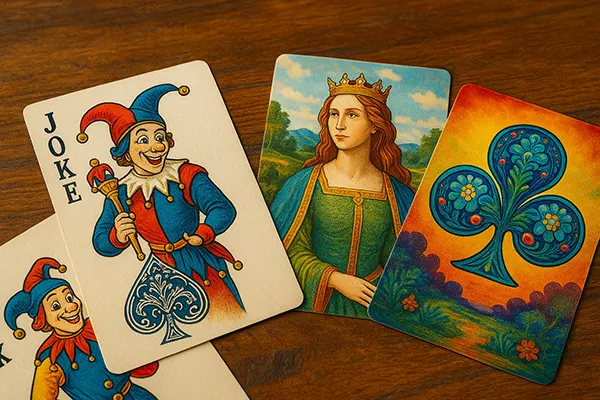
Art of Cards: How Playing Card Design Became a Collectible Art Form
Playing cards have long transcended their initial function as simple gaming tools. Today, they’re a form of artistic expression, collector’s item, and even a digital asset. From hand-engraved face cards of centuries past to modern NFT releases, card design has grown into a niche where craftsmanship meets creativity. This article explores how the visual world of playing cards evolved into a respected segment of collectible and digital art.
Designer Decks and Limited Editions
Limited-edition designer decks have sparked a renaissance in how we perceive traditional playing cards. Brands like Theory11 and Ellusionist lead this movement, often collaborating with renowned illustrators and film studios to craft visually stunning decks. Each release becomes a thematic story, where court cards, jokers, and aces are elevated into miniature canvases of storytelling.
For instance, Theory11’s collaborations with Star Wars and James Bond franchises demonstrate how cinematic worlds can be adapted into the intricate language of card design. Every deck balances functionality with visual splendour, using luxury materials like gold foil, embossed finishes, and premium paper stock to enhance the tactile experience.
Collectors are drawn to the scarcity of these editions, often limited to a few thousand units. Some releases sell out within hours, only to reappear on secondary markets at significantly inflated prices. Their value lies not only in rarity but in the narrative and craftsmanship behind each piece.
The Rise of Card Collectors
The global playing card community now includes thousands of collectors who treat decks as fine art. Social platforms like Instagram and forums like United Cardists have allowed this subculture to flourish, with users showcasing storage cases, curated walls, and archival-quality preservation methods.
Collectors often focus on specific themes—vintage casino decks, tarot hybrids, minimalist art, or period-based styles such as Victorian or Art Deco. Some even collect artist-signed or numbered editions, which elevate a mass-produced object into a personal artefact.
High-end auctions are increasingly seeing rare decks fetch impressive sums. For example, 19th-century transformation decks—cards where the pips are cleverly integrated into illustrations—can command several thousand pounds at collectors’ events or online marketplaces like eBay or Sotheby’s subsidiary platforms.
Historical Engravings and Artistic Lineage
The history of playing card art reaches back centuries, intertwining with techniques such as woodcut and copper engraving. During the Renaissance, European artisans meticulously crafted each card by hand, often modelling figures on local nobility or literary characters. These artefacts were more than game tools—they were miniature reflections of culture and class.
One of the earliest known decks, the Stuttgart Playing Cards (circa 1430), showcases court figures dressed in Gothic fashion, revealing the interplay between society and design. Unlike today’s symmetrical layouts, these early cards were entirely hand-painted, reflecting the style and symbolism of the region they originated from.
As printing technology advanced, card designs spread more widely. Still, artistic quality remained high in many regions, particularly in France, Germany, and Italy. Some of these antique decks are preserved in museums or private collections and are referenced today by designers seeking authenticity in their modern interpretations.
Transformation Cards as Artistic Milestones
One of the most celebrated formats in card art history is the transformation deck. Here, card pips (hearts, diamonds, clubs, and spades) are not merely printed but cleverly incorporated into scenes—forming parts of landscapes, animals, or figures. These began gaining popularity in the early 1800s and are now iconic examples of creativity within strict rules.
Modern artists have revived this concept, pushing it further with surrealism, abstraction, and contemporary humour. Each transformation deck becomes a puzzle as well as a work of art, blending logic with aesthetic intuition. The reinterpretation of classic forms through modern lenses has brought renewed attention to these older formats.
Some luxury publishers even offer bespoke services, allowing private clients to commission personalised transformation decks with unique narratives, characters, or family symbols—a fusion of tradition, storytelling, and artistry.

Digital Evolution: NFTs and Virtual Collecting
With the rise of blockchain technology, playing cards have entered the digital sphere through non-fungible tokens (NFTs). These assets allow for digital ownership of card designs, often presented as limited collections or interactive sets. Artists now release NFT card projects that push the boundary between static design and programmable media.
Platforms like OpenSea have hosted entire NFT deck releases, where each card exists as a unique, traceable item. Some projects feature dynamic elements—cards that animate, evolve with player interaction, or unlock access to exclusive communities or games. The transition from printed matter to pixel-based creation has opened entirely new avenues for both artists and collectors.
This shift does not replace traditional cards but expands their possibilities. While some purists may resist the digitalisation of a tactile art form, others embrace it as a frontier that preserves collectibility while embracing future-forward design principles and decentralised ownership.
The Role of Independent Artists in NFT Cards
Independent illustrators and digital artists are now able to break into the card world without a physical publisher. Self-funded NFT decks give creators more artistic freedom, direct engagement with buyers, and control over distribution. Through crowd-funding or early access sales, artists can finance production and create unique experiences around their digital decks.
This decentralised approach is reshaping the landscape of card art. Artists from countries with limited publishing infrastructure now find a global audience. A single card design—once limited by print runs—can now live eternally on the blockchain, immune to physical degradation or geographical limitation.
It also redefines the meaning of a “deck.” In digital space, there’s no requirement for 52 cards or standard suits—some artists explore symbolic systems, narrative arcs, or abstract sequences, blurring the boundary between card game, visual art, and digital storytelling.
